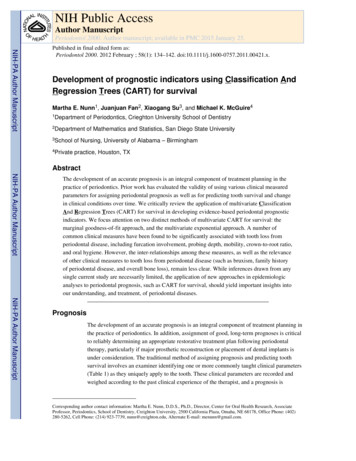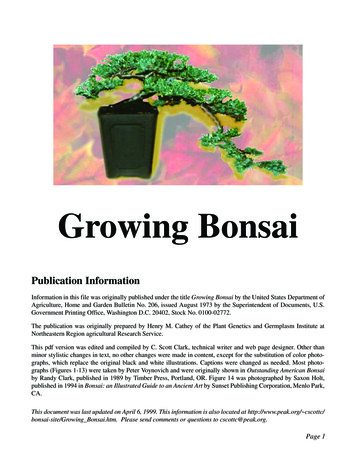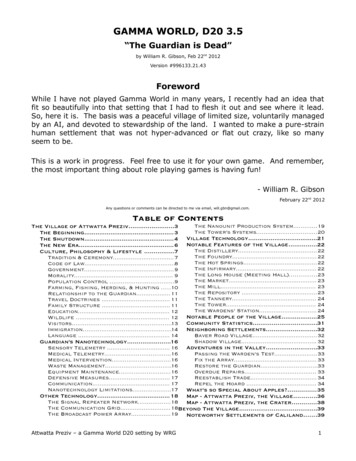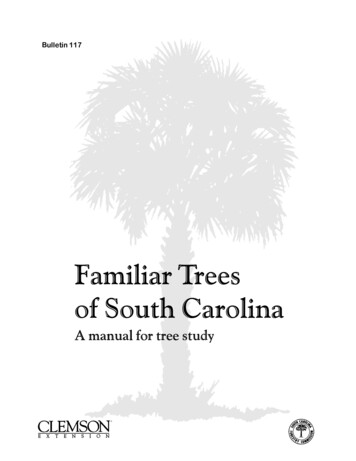
Transcription
Machine Learning manuscript No.(will be inserted by the editor)Optimal Survival TreesDimitris Bertsimas · Jack Dunn · Emma Gibson ·Agni OrfanoudakiReceived: date / Accepted: dateAbstract Tree-based models are increasingly popular due to their ability to identify complex relationshipsthat are beyond the scope of parametric models. Survival tree methods adapt these models to allow for theanalysis of censored outcomes, which often appear in medical data. We present a new Optimal SurvivalTrees algorithm that leverages mixed-integer optimization (MIO) and local search techniques to generateglobally optimized survival tree models. We demonstrate that the OST algorithm improves on the accuracyof existing survival tree methods, particularly in large datasets.Keywords survival analysis, non-parametric models, recursive partitioning, censored data1 IntroductionSurvival analysis is a cornerstone of healthcare research and is widely used in the analysis of clinical trialsas well as large-scale medical datasets such as Electronic Health Records and insurance claims. Survivalanalysis methods are required for censored data in which the outcome of interest is generally the time untilan event (onset of disease, death, etc.), but the exact time of the event is unknown (censored) for someindividuals. When a lower bound for these missing values is known (for example, a patient is known to bealive until at least time t) the data is said to be right-censored.A common survival analysis technique is Cox proportional hazards regression (Cox, 1972) which modelsthe hazard rate for an event as a linear combination of covariate e ects. Although this model is widely usedand easily interpreted, its parametric nature makes it unable to identify non-linear e ects or interactionsbetween covariates (Bou-Hamad et al., 2011).Recursive partitioning techniques (also referred to as trees) are a popular alternative to parametricmodels. When applied to survival data, survival tree algorithms partition the covariate space into smallerand smaller regions (nodes) containing observations with homogeneous survival outcomes. The survivaldistribution in the final partitions (leaves) can be analyzed using a variety of statistical techniques such asKaplan-Meier curve estimates (Kaplan and Meier, 1958).Most recursive partitioning algorithms generate trees in a top-down, greedy manner, which means thateach split is selected in isolation without considering its e ect on subsequent splits in the tree. However,Bertsimas and Dunn (Bertsimas and Dunn, 2017, 2019) have proposed a new algorithm which uses modernDimitris BertsimasOperations Research Center, E40-111, Massachusetts Institute of Technology, Cambridge, MA 02139, USA. E-mail: dbertim@mit.eduJack DunnOperations Research Center, E40-111, Massachusetts Institute of Technology Cambridge, MA 02139, USA. E-mail:jack@interpretable.aiEmma GibsonOperations Research Center, E40-111, Massachusetts Institute of Technology Cambridge, MA 02139, USA. E-mail: emgibson@mit.eduAgni OrfanoudakiOperations Research Center, E40-111, Massachusetts Institute of Technology Cambridge, MA 02139, USA. E-mail:agniorf@mit.edu
mixed-integer optimization (MIO) techniques to form the entire decision tree in a single step, allowingeach split to be determined with full knowledge of all other splits. This Optimal Trees algorithm allowsthe construction of single decision trees for classification and regression that have performance comparablewith state-of-the-art methods such as random forests and gradient boosted trees, without sacrificing theinterpretability o ered by a single-tree model.The key contributions of this paper are:1. We present Optimal Survival Trees (OST), a new survival trees algorithm that utilizes the OptimalTrees framework to generate interpretable trees for censored data.2. We propose a new accuracy metric that evaluates the fit of Kaplan-Meier curve estimates relative toknown survival distributions in simulated datasets. We also demonstrate that this metric is consistentwith the Integrated Brier Score (Graf et al., 1999), which can be used to evaluate the fit of Kaplan-Meiercurves when the true distributions are unknown.3. We evaluate the performance of our method in both simulated and real-world datasets and demonstrateimproved accuracy relative to two existing algorithms.4. Finally, we provide an example of how the algorithm can be used to predict the risk of adverse eventsassociated with cardiovascular health in the Framingham Heart Study (FHS) dataset.The structure of this paper is as follows. We review existing survival tree algorithms in Section 2 anddiscuss some of the technical challenges associated with building trees for censored data. In Section 3,we give an overview of the Optimal Trees algorithm proposed by Bertsimas and Dunn and we adapt thisalgorithm for Optimal Survival Trees in Section 4. Section 5 begins with a discussion of existing survivaltree accuracy metrics, followed by the new accuracy metrics that we have introduced to evaluate survivaltree models in simulated datasets. Simulation results are presented in Section 6 and results for real-worlddatasets are presented in Sections 7–8. We conclude in Section 9 with a brief summary of our contributions.2 Review of Survival TreesRecursive partitioning methods have received a great deal of attention in the literature, the most prominentmethod being the Classification and Regression Tree algorithm (CART) (Breiman et al., 1984). Tree-basedmodels are appealing due to their logical, interpretable structure as well as their ability to detect complexinteractions between covariates. However, traditional tree algorithms require complete observations of thedependent variable in training data, making them unsuitable for censored data.Tree algorithms incorporate a splitting rule which selects partitions to add to the tree, and a pruningrule determines when to stop adding further partitions. Since the 1980s, many authors have proposedsplitting and pruning rules for censored data. Splitting rules in survival trees are generally based on either(a) node distance measures that seek to maximize the di erence between observations in separate nodesor (b) node purity measures that seek to group similar observation in a single node (Zhou and McArdle,2015; Molinaro et al., 2004).Algorithms based on node distance measures compare the two adjacent child nodes that are generatedwhen a parent node is split, retaining the split that produces the greatest di erence in the child nodes.Proposed measures of node distance include the two-sample logrank test (Ciampi et al., 1986), the likelihoodratio statistic (Ciampi et al., 1987) and conditional inference permutation tests (Hothorn et al., 2006). Wenote that the score function used in Cox regression models also falls into the class of node distance measures,as the partial likelihood statistic is based on a comparison of the relative risk coefficient predicted for eachobservation.Dissimilarity-based splitting rules are unsuitable for certain applications (such as the Optimal Treesalgorithm) because they do not allow for the assessment of a single node in isolation. We will thereforefocus on node purity splitting rules for developing the OST algorithm.Gordon and Olshen (1985) published the first survival tree algorithm with a node purity splitting rulebased on Kaplan-Meier estimates. Davis and Anderson (1989) used a splitting rule based on the negativelog-likelihood of an exponential model, while Therneau et al. (1990) proposed using martingale residualsas an estimate of node error. LeBlanc and Crowley (1992) suggested comparing the log-likelihood of asaturated model to the first step of a full likelihood estimation procedure for the proportional hazardsmodel and showed that both the full likelihood and martingale residuals can be calculated efficiently fromthe Nelson-Aalen cumulative hazard estimator (Nelson, 1972; Aalen, 1978). More recently, Molinaro et al.(2004) proposed a new approach to adjust loss functions for uncensored data based on inverse probabilityof censoring weights (IPCW).2
Most survival tree algorithms make use of cost-complexity pruning to determine the correct tree size,particularly when node purity splitting is used. Cost-complexity pruning selects a tree that minimizes aweighted combination of the total tree error (i.e., the sum of each leaf node error) and tree complexity(the number of leaf nodes), with relative weights determined by cross-validation. A similar split-complexitypruning method was suggested by LeBlanc and Crowley (1993) for node distance measures, using the sumof the split test statistics and the number of splits in the tree. Other proposals include using the AkaikeInformation Criterion (AIC) (Ciampi et al., 1986) or using a p-value stopping criterion to stop growing thetree when no further significant splits are found (Hothorn et al., 2006).Survival tree methods have been extended to include “survival forest” algorithms which aggregate theresults of multiple trees. Breiman (2002) adapted the CART-based random forest algorithm to survivaldata, while both Hothorn et al. (2004) and Ishwaran et al. (2008) proposed more general methods thatgenerate survival forests from any survival tree algorithm. The aim of survival forest models is to producemore accurate predictions by avoiding the instability of single-tree models. However, this approach leadsto “black-box” models which are not interpretable and therefore lack one of the primary advantages ofsingle-tree models.Relatively few survival tree algorithms have been implemented in publicly available, well-documentedsoftware. Two user-friendly options are available in R (R Core Team, 2017) packages: Therneau’s algorithmbased on martingale residuals is implemented in the rpart package (Therneau et al., 2010) and Hothorn’sconditional inference (ctree) algorithm in the party package (Hothorn et al., 2010).3 Review of Optimal Predictive TreesIn this section, we briefly review approaches to constructing decision trees, and in particular, we outlinethe Optimal Trees algorithm. The purpose of this section is to provide a high-level overview of the OptimalTrees framework; interested readers are encouraged to refer to Bertsimas and Dunn (2019) and Dunn(2018) for more detailed technical information. The Optimal Trees algorithm and is implemented in Julia(Bezanson et al., 2017) and is available to academic researchers under a free academic license.1Traditionally, decision trees are trained using a greedy heuristic that recursively partitions the featurespace using a sequence of locally-optimal splits to construct a tree. This approach is used by methods likeCART (Breiman et al., 1984) to find classification and regression trees. The greediness of this approach isalso its main drawback—each split in the tree is determined independently without considering the possibleimpact of future splits in the tree on the quality of the here-and-now decision. This can create difficulties inlearning the true underlying patterns in the data and lead to trees that generalize poorly. The most naturalway to address this limitation is to consider forming the decision tree in a single step, where each split inthe tree is decided with full knowledge of all other splits.Optimal Trees is a novel approach for decision tree construction that significantly outperforms existingdecision tree methods (Bertsimas and Dunn, 2019). It formulates the decision tree construction problemfrom the perspective of global optimality using mixed-integer optimization (MIO), and solves this problemwith coordinate descent to find optimal or near-optimal solutions in practical run times. These OptimalTrees are often as powerful as state-of-the-art methods like random forests or boosted trees, yet they arejust a single decision tree and hence are readily interpretable. This obviates the need to trade o betweeninterpretability and state-of-the-art accuracy when choosing a predictive method.The Optimal Trees framework is a generic approach that tractably and efficiently trains decision treesaccording to a loss function of the formmin error(T, D) · complexity(T ),T(1)where T is the decision tree being optimized, D is the training data, error(T, D) is a function measuringhow well the tree T fits the training data D, complexity(T ) is a function penalizing the complexity of thetree (for a tree with splits parallel to the axis, this is simply the number of splits in the tree), and is thecomplexity parameter that controls the tradeo between the quality of the fit and the size of the tree.There have been many attempts in the literature to construct globally optimal predictive trees (Bennettand Blue, 1996; Son, 1998; Grubinger et al., 2014). However, these methods could not scale to datasets ofthe sizes required by practical applications, and therefore did not displace greedy heuristics as the approachused in practice. Unlike the others, Optimal Trees is able scale to large datasets (n in the millions, p inthe thousands) by using coordinate descent to train the decision trees towards global optimality. When1Please email survival-trees@mit.edu to request an academic license for the Optimal Survival Trees package.3
Out of sample accuracy858075702CART46Maximum depth of treeOCTOCT H8Random Forest10BoostingFig. 1: Performance of classification methods averaged across 60 real-world datasets. OCT and OCT-Hrefer to Optimal Classification Trees without and with hyperplane splits, respectively.training a tree, the splits in the tree are repeatedly optimized one-at-a-time, finding changes that improvethe global objective value in Problem (1). To give a high-level overview, the nodes of the tree are visitedin a random order and at each node we consider the following modifications:– If the node is not a leaf, delete the split at that node;– If the node is not a leaf, find the optimal split to use at that node and update the current spli
We present Optimal Survival Trees (OST), a new survival trees algorithm that utilizes the Optimal Trees framework to generate interpretable trees for censored data. 2.











